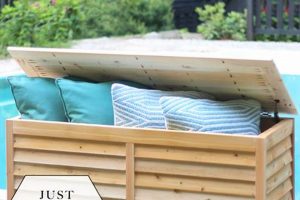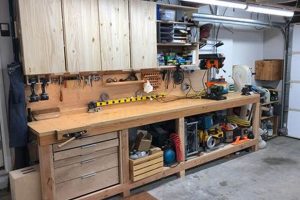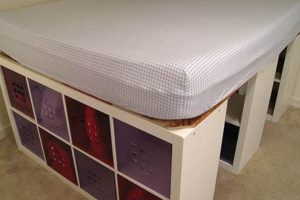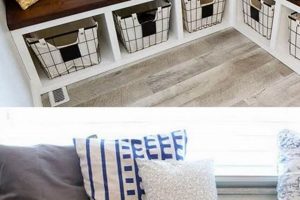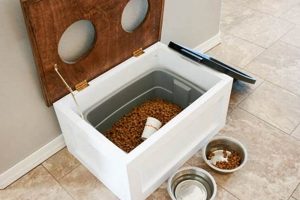A furniture piece combining seating, storage, and often an organizational hub, typically located near an entryway, serves a practical purpose in managing outdoor gear and personal belongings. These structures can range from simple, repurposed benches with added shelving to more complex, custom-built units incorporating drawers, cubbies, and coat racks. They are designed to streamline the process of entering and exiting a residence.
Implementing such a system at a home’s entrance provides immediate benefits for organization and cleanliness. By providing a designated space for shoes, coats, and bags, it minimizes clutter tracked into the home’s main living areas. Historically, dedicated mudrooms were common in rural homes to keep agricultural debris separate. Modern versions are tailored to address the needs of contemporary lifestyles, contributing to both aesthetic appeal and enhanced functionality.
The subsequent sections will explore material selection, design considerations, and step-by-step construction methods for creating a customized organizational solution for an entryway. These considerations facilitate efficient space utilization and personal expression within the home.
Construction and Design Guidance
The following guidelines are intended to improve the outcome of crafting an entryway organizational unit. Attention to detail and careful planning are crucial to a successful project.
Tip 1: Precise Measurement and Planning: Accurate dimensions of the available space are paramount. Before initiating construction, a detailed plan that includes the dimensions, materials, and joinery methods should be developed. This plan serves as a blueprint, minimizing errors and material waste.
Tip 2: Durable Material Selection: The selection of materials directly impacts the longevity and structural integrity of the unit. Solid wood, plywood, or moisture-resistant MDF are appropriate choices for components subject to heavy use or potential exposure to water and dirt. Consider the environment where the structure will reside when selecting materials.
Tip 3: Ergonomic Seating Height: The seating height should align with average human anthropometric data to provide comfortable use. A height between 16 and 20 inches from the floor is generally considered optimal for accommodating a range of users. Testing the height with potential users is advised.
Tip 4: Integrated Storage Solutions: Incorporate a variety of storage options to accommodate diverse needs. Drawers, open shelving, and cubbies can be combined to organize shoes, bags, and other personal items. The inclusion of coat hooks or a hanging rod maximizes vertical space and further enhances organizational capabilities.
Tip 5: Secure Assembly Techniques: Use appropriate joinery methods to ensure the structural integrity of the unit. Options include screws, nails, dowels, or mortise-and-tenon joints, depending on the materials and tools available. Gluing joints in addition to mechanical fasteners increases strength and durability.
Tip 6: Surface Treatment and Protection: Applying a finish protects the unit from moisture, wear, and tear. Paint, stain, or a clear sealant can be used, depending on the desired aesthetic and the material being used. Multiple coats are recommended for enhanced protection.
Tip 7: Consider Ventilation: When designing enclosed storage spaces, incorporate ventilation to prevent moisture buildup and odor. Small vents or gaps can be integrated into doors or panels to allow for air circulation.
Adhering to these guidelines will result in a functional and aesthetically pleasing addition to the entryway, contributing to an organized and welcoming home environment.
The subsequent section will address advanced design techniques and personalized customization options.
1. Material Durability
The selection of durable materials is paramount for the longevity and functionality of a mudroom storage bench. Given its location near entryways, the bench is exposed to significant wear and tear from outdoor elements, including moisture, dirt, and abrasion from footwear and gear. Inadequate material choices can lead to premature degradation, structural failure, and increased maintenance costs. For example, using untreated softwood in a high-humidity environment can result in warping, rot, and infestation by pests. A properly constructed bench depends on selecting materials that withstand these conditions.
The implementation of moisture-resistant materials, such as pressure-treated lumber or specific hardwood species, significantly mitigates the risk of water damage. Applying protective coatings, such as polyurethane or epoxy resin, further enhances resistance to moisture and abrasion. For instance, constructing a bench from marine-grade plywood coated with multiple layers of polyurethane provides superior protection in areas prone to water exposure. The choice of fasteners, such as stainless steel screws, also plays a critical role in preventing corrosion and maintaining structural integrity over time.
Therefore, prioritizing material durability is essential for ensuring the mudroom storage bench’s long-term performance and aesthetic appeal. Neglecting this aspect can lead to costly repairs or replacements, undermining the initial investment in time and resources. The strategic selection of durable materials, coupled with appropriate protective measures, ensures that the bench remains a functional and visually appealing element within the home environment for years to come.
2. Structural Integrity
Structural integrity is paramount in the construction of a mudroom storage bench, as it directly determines the bench’s ability to withstand intended loads and usage over time. A bench lacking sufficient structural robustness poses safety risks and functional limitations. For instance, a poorly constructed bench may collapse under the weight of multiple users or stored items, leading to potential injury. The structural design must consider factors such as material strength, joint construction, and load distribution to ensure stability and longevity. Insufficient attention to these elements compromises the entire purpose of the structure.
Effective structural design incorporates several key principles. The selection of appropriate materials, such as solid wood or high-quality plywood, provides a solid foundation. Joinery techniques, including mortise-and-tenon joints, dovetail joints, or secure screw and adhesive combinations, reinforce connections between structural components. The incorporation of reinforcing elements, such as stretchers or aprons, distributes weight and prevents racking. For example, a bench constructed with adequately sized lumber, properly spaced support structures, and robust joinery can safely accommodate significant weight without deformation or failure. These structural elements ensure long-term stability and reliable performance.
In summary, the structural integrity of a mudroom storage bench is a non-negotiable aspect of its design and construction. Compromises in this area can lead to safety hazards, functional limitations, and reduced lifespan. By adhering to sound engineering principles and employing appropriate materials and construction techniques, it is possible to create a robust and reliable bench that meets the demands of a high-traffic entryway while providing safe and effective storage and seating solutions.
3. Space Optimization
In the context of a do-it-yourself entryway organizational unit, space optimization refers to the strategic arrangement and utilization of available area to maximize storage capacity and functionality while minimizing spatial footprint. Effective space optimization ensures that the furniture piece efficiently addresses storage needs without impeding traffic flow or diminishing the aesthetic appeal of the entry area. This is particularly critical in smaller homes or apartments where space is at a premium.
- Vertical Space Utilization
This involves extending the storage unit upwards, rather than outwards, to exploit the often underutilized vertical dimension. This can be achieved through the incorporation of shelves, cubbies, or coat hooks positioned above the seating area. For example, a floor-to-ceiling unit maximizes storage capacity without expanding the bench’s footprint, making it suitable for narrow entryways. The effective use of vertical space can significantly increase storage capacity while maintaining a streamlined appearance.
- Multifunctional Design
The concept of multifunctional design refers to the integration of multiple functionalities into a single furniture piece. A bench that provides seating, storage, and organization for outerwear and accessories epitomizes this principle. For instance, a bench with a hinged seat offers concealed storage, while integrated hooks provide convenient hanging space for coats and bags. Multifunctional designs reduce the need for additional furniture, thereby conserving space and enhancing efficiency.
- Customized Dimensions and Configuration
Customization allows the bench to be tailored to the precise dimensions and spatial constraints of the entryway. Unlike prefabricated furniture, a do-it-yourself approach enables the construction of a unit that perfectly fits the available space. This can involve adjusting the width, depth, and height of the bench to maximize storage capacity and optimize traffic flow. Customized dimensions ensure that the bench integrates seamlessly into the entry area, avoiding awkward gaps or obstructions.
- Integrated Organizational Accessories
The inclusion of internal dividers, removable bins, and adjustable shelving enhances the bench’s organizational capabilities. These accessories allow for the efficient sorting and storage of various items, such as shoes, hats, and gloves. For example, shoe dividers within the storage compartment prevent clutter and maximize the number of pairs that can be stored. Integrated organizational accessories promote a tidy and efficient entryway, contributing to overall space optimization.
These integrated strategies are essential to maximizing space utilization. By fully utilizing available vertical space, combining multiple functions, customizing the design to the entry area’s parameters, and integrating organizational accessories, the unit significantly contributes to a more organized and welcoming entry area. These techniques enable a more efficient and aesthetically pleasing use of space within the home.
4. Ergonomic Design
Ergonomic design is a critical consideration in the construction of a functional and user-friendly entryway organizational structure. The principles of ergonomics, which focus on optimizing the interaction between humans and their environment, directly impact the usability, comfort, and safety of the furniture piece. Neglecting ergonomic considerations can lead to discomfort, strain, and potentially increase the risk of injury, thereby undermining the intended benefits of the bench.
- Seating Height and Depth
The height and depth of the seating surface significantly affect user comfort. A seating height that is too low or too high can strain the knees and hips during sitting and standing. Similarly, inadequate seat depth can compromise back support and overall comfort. An ideal seating height typically falls between 16 and 20 inches, while seat depth should provide sufficient support without being excessively deep, generally between 14 and 18 inches. Adapting these dimensions to accommodate the height and physical characteristics of anticipated users improves the functionality and accessibility of the bench.
- Storage Accessibility
The ease of accessing storage compartments is a key ergonomic consideration. Awkwardly positioned or difficult-to-open drawers, shelves, or bins can lead to frustration and physical strain. Storage components should be easily reachable and operable without excessive bending, stretching, or lifting. For example, incorporating pull-out drawers or lightweight bins with ergonomic handles improves accessibility. The design should accommodate users with varying levels of physical ability.
- Load Management and Weight Distribution
The ability to safely manage and distribute the weight of stored items is crucial for preventing injury. The design should consider the maximum load capacity of storage compartments and provide mechanisms to prevent items from shifting or falling. For instance, adjustable shelves with secure locking mechanisms can accommodate items of different sizes and weights. The structural design should also distribute weight evenly to prevent instability or tipping.
- Clearance and Movement Space
Sufficient clearance around the bench and adjacent areas is essential for safe and comfortable movement. Obstructions or confined spaces can increase the risk of trips, falls, and collisions. The design should allow for adequate space for users to sit, stand, and maneuver around the bench without impediment. The placement of the unit within the entryway should consider the overall traffic flow and minimize potential hazards.
Integrating ergonomic principles into the design and construction of an entryway organizational unit enhances its practicality, user satisfaction, and safety. By carefully considering factors such as seating height, storage accessibility, load management, and clearance, it is possible to create a furniture piece that effectively serves its intended purpose while minimizing the risk of discomfort or injury. A well-designed bench contributes to a more functional and welcoming home environment.
5. Aesthetic Cohesion
Aesthetic cohesion, in the context of an entryway organizational unit, signifies the harmonious integration of the furniture piece with the existing interior design elements of the surrounding space. The absence of aesthetic cohesion can result in a jarring visual disruption, diminishing the overall appeal of the entry area and potentially detracting from the home’s perceived value. A mudroom storage bench that clashes with the established color palette, architectural style, or material finishes disrupts the sense of visual unity and creates a disharmonious impression. The selection of design elements must therefore reflect consideration for the units integration with its surroundings.
Achieving aesthetic cohesion involves careful consideration of several factors. Color selection should complement or contrast intentionally with the existing wall colors, flooring, and trim. Material choices should align with the prevalent architectural style, whether it be modern, traditional, or rustic. For example, a contemporary home might benefit from a storage bench constructed from sleek, minimalist materials such as metal and glass, while a farmhouse-style residence might call for a bench crafted from reclaimed wood with a distressed finish. Hardware choices, such as knobs and hinges, should also complement the overall aesthetic. This ensures that the unit integrates seamlessly into the existing dcor.
In conclusion, aesthetic cohesion is a crucial element in the successful implementation of a mudroom storage bench. Ignoring this aspect can lead to a visually disruptive outcome, detracting from the overall appeal of the entryway. By carefully considering color, material, and style, and integrating the unit into the existing dcor, homeowners can create an entryway that is both functional and aesthetically pleasing, enhancing the overall ambiance of the home. This creates a well-balanced and inviting area for the household and guests.
Frequently Asked Questions
This section addresses common inquiries regarding the design, construction, and maintenance of do-it-yourself entryway organizational units. The information presented aims to clarify misconceptions and provide practical guidance for successful implementation.
Question 1: What is the optimal material for constructing a durable seating surface?
Solid hardwood, such as maple or oak, and high-quality plywood offer superior durability for seating surfaces. These materials withstand heavy use and resist denting or scratching. The selection should align with the intended aesthetic and budget constraints.
Question 2: How can stability be ensured during construction?
Employing robust joinery techniques, such as mortise-and-tenon or dovetail joints, and reinforcing corners with brackets or supports are crucial for structural stability. These methods distribute weight effectively and prevent wobbling or collapse.
Question 3: What is the recommended height for a seating surface?
A seating height between 16 and 20 inches is generally considered ergonomically suitable for most adults. This range allows for comfortable sitting and standing without excessive strain on the knees or hips.
Question 4: How can moisture damage be prevented?
Applying a waterproof sealant or paint to all surfaces, particularly those exposed to moisture, is essential. Consider using materials that are naturally water-resistant, such as cedar or teak, in high-moisture environments.
Question 5: What methods can be used to maximize storage capacity in a limited space?
Vertical storage solutions, such as shelves or hooks mounted above the seating area, and integrated storage compartments beneath the seating surface are effective strategies for maximizing storage capacity in confined spaces.
Question 6: How should the design integrate with the existing home decor?
Selecting materials, colors, and finishes that complement the existing architectural style and color palette of the home is crucial for achieving aesthetic cohesion. Consider the overall design aesthetic when choosing hardware and accessories.
Proper planning and execution are essential for crafting a functional and aesthetically pleasing entryway solution. Addressing these key considerations ensures the long-term value and usability of the project.
The subsequent section will explore advanced customization techniques and decorative enhancements.
diy mudroom storage bench
This exposition has detailed critical aspects pertaining to the design, construction, and implementation of a functional and aesthetically integrated storage solution for residential entryways. The strategic selection of durable materials, the adherence to structural integrity principles, the optimization of spatial efficiency, the incorporation of ergonomic design elements, and the maintenance of aesthetic cohesion represent essential considerations for successful project completion. The principles outlined serve as a framework for informed decision-making.
Given the multifaceted nature of this undertaking, prospective builders must exercise diligence and precision in their endeavors. The creation of a robust, enduring, and visually congruous “diy mudroom storage bench” requires a comprehensive understanding of design principles, construction techniques, and material properties. This careful application of knowledge ensures the project’s success and its long-term contribution to a functional and organized home environment.


